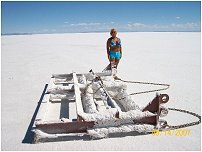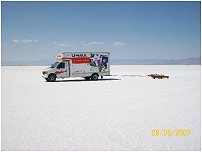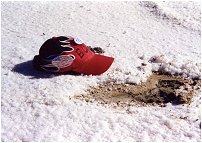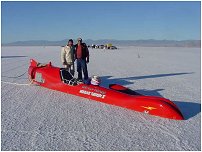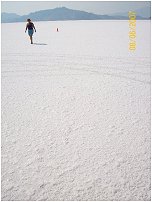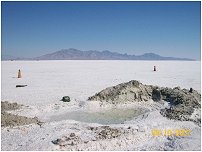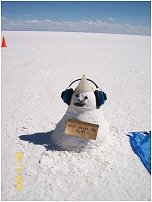


I've been asked about a jillion times -- "How smooth is the Salt out at Bonneville?" Well, it's pretty smooth -- but the natural process of drying after the winter's rains usually leaves small bumps and pressure ridges -- maybe a couple of inches tall. To prepare the course for the super-high speeds we run, volunteer workers attach big drags, like this one, behind trucks and pull them back and forth, up and down the course, over and over, 'til the course is as smooth as we can get it. Some of the drags have extra weights on them for better smoothing action, some, like this one, are set up to be lighter but to help "cut" the ridges better. I asked Nancy to stand by this one so you could get a better perspective of how big is the drag.
|
|
Here's a truck pulling one of the drags to smooth the salt. There are two race courses at Bonneville. The "short" course is for slower vehicles and is a total of five miles long, and the "long" course is at least seven miles long. The courses are about 100 feet wide, and usually at least two side-by-side courses are set up for each. Let's see -- two times 7 miles is 14, plus 2 times 5 is ten more, for a total of 24 miles. Since the drags are about ten feet wide and the course is 100 feet, and allow for some overlap, so it take a dozen passes to cover the 100-foot-wide course, and since there are four courses, make that 4 dozen. Still with me? The drags must move slowly to work best -- about 8 mph is optimum, I hear. So do the math and you'll see that: 24 miles of course divided by 8 mph equals three hours to make one Complete" pass, time twelve passes per course (width) makes 36 hours, then expect at least three repeats -- 96 hours of dragging to prepare the courses! Nancy and I have had the dubious pleasure of operating a drag truck one night - from about 6pm 'til 11. The truck we ran is old -- so old that it doesn't have much in the way of amenities, like lights -- so we had to drive in the dark, trailing about 100 feet behind the truck in front of us and following his lights. It was sort of romantic, though -- there was a fine display of lightning from a storm over the mountains, and we were (sort of) all alone out there. Okay -- now you know that the course isn't perfect by nature, but is made as close as possible to perfect by man.
|
|
| I took this shot a couple of years ago -- so you could see just how thin is the layer of salt that rests atop the mud. The Bonneville Salt Flats is a lake -- from geological times to the present. It floods each winter and dries up during the warm months, each time leaving another thousandth or so of an inch of salt. Do that for a bunch of years -- and viola, you've got salt flats.
|
|
| This is a photo of Jack Costella and Rick Yacoucci (Jack on the right, built the car, and Rick drives it -- now owns it, I think). I've got the photo here so you can get yet another idea of the smoothness of the salt. Oh, yeah -- powered by a 1400cc motorcycle engine -- this car has gone over 322 miles per hour. | |
| Nancy and I get to the events a few days or more before the beginning of activities - to help with set up. Here she is as we were setting out some of the thousands of traffic cones. You can see the surface detail of the salt -- and some faint tire tracks. The salt wasn't perfectly dry when this photo was taken (it had rained a week or two before), so the salt sticks to tires (and to shoes) and that's why you can see the tracks. | |
| This photos shows the huge "divot" left when a truck broke through the salt and got stuck in the mud below -- but you can see how close to the surface is the water table. I put my hat down on the salt to give some perspective. As long as you're looking at this photo -- note just how flat and wide open it is at Bonneville. Look really carefully at the horizon on the left side of the photo -- you'll see a couple of vehicles. They're probably two miles away. The mountains are about seven or eight miles away from this hole in the mud. | |
| Some racers have a bit too much spare time when they've blown up their race vehicles and have nothing else to do. This is a good example of a "salt gremlin". |
